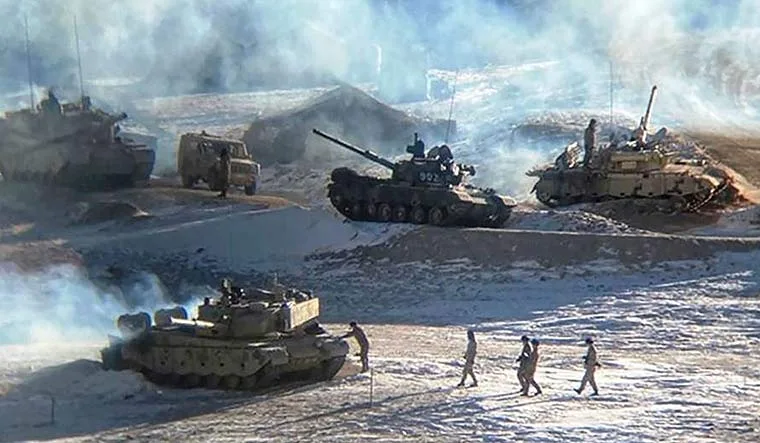The latest US intelligence report issued on Wednesday has advocated Washington’s intervention to resolve the India-China border standoff, which has entered its third year.
The Annual Threat Assessment report makes three broad points to justify US intervention to ease tensions between India and China. First, it points out that the risk of armed conflict between India and China has elevated after the 2020 Galwan clash. Second, the possibility of a nuclear clash as the two countries are atomic weapon powers is not in Washington’s interest, implying an urgency to ease tensions. Third, the two countries are prone to rapid military escalation given their past record.
“The expanded military postures by both India and China along the disputed border elevate the risk of armed confrontation between two nuclear powers that might involve direct threats to U.S. persons and interests and calls for U.S. intervention. Previous standoffs have demonstrated that persistent low-level friction on the Line of Actual Control (LAC) has the potential to escalate swiftly,” notes the report.
Referring to the Galwan incident, the report predicts that relations between the two countries will “remain strained in the wake of the countries’ lethal clash in 2020, the most serious in decades”.
–#USA’s intel community’s annual threat assessment is out
-It says: #India & #China along the disputed border elevate the risk of armed confrontation & direct threats to U.S. persons and interests, and calls for U.S. intervention pic.twitter.com/9ym6nirvVW— Insightful Geopolitics (@InsightGL) March 9, 2023
While the US may have the intent to intervene, its capacity to play a meaningful role is likely to be restricted. Unlike in other theatres such as Pakistan, Washington has diminishing leverage with China, reducing its capacity to persuade Beijing to change tack.
Besides, China is unlikely to remain in listening mode as it is engaged in full-throttled competition with the United States for ascendancy in the global system. The rivalry between the two makes it highly unlikely that Beijing will accept Washington as an honest broker in defusing tensions with India.
Given little role for third-party intervention, India has no option but to internalise, in fact, it might have already done so, that it has to mend border ties with China alone, on its own steam. This may take several years if not more before a breakthrough can be achieved.
The Chinese are known to play hardball, and past record shows that they have gone for border settlements, either under the pressure of a rival’s power, or due to pressing geopolitical circumstances. For instance, the Chinese settled their border with Russia, after Moscow and Washington were showing signs of bonding after the second Gulf war, which would have left Beijing out of emerging great-power equations.
India, therefore, has to build real capability, a solid multi-layered deterrent, as well a capacity to launch offensive operations, before China can be persuaded to bargain a thaw on the border.
There are several areas where India has to build capacities, before the hard-boiled Chinese are persuaded to accept a give-and-take approach to resolve the situation along the Line of Actual Control (LAC), preceding a final border settlement.
First, at a strategic level, India would need to acquire a reliable arsenal of stand-off weapons, including missiles that can evade China’s anti-missile defences. Apart from the Agni-series of solid-fuelled missiles, India will have to quicken the pace of induction of Submarine Launched Ballistic Missiles that mount atomic warheads. India’s programme of the SSBN’s—nuclear submarine that board nuclear tipped ballistic missiles, led by INS Arihant, will need to be accelerated. There is an urgent need to build an arsenal of hypersonic missiles which can crash through any known anti-missile defences.
Second, in the maritime domain, India has to quickly implement its plans that will convince China that New Delhi has the capacity to impede Beijing’s commercial shipping as it passes through the 10 degree and six-degree channels in the Andaman and Nicobar islands. These channels are vital for the free-flow of Chinese trade, as commercial ships pass through these channels before entering the Malacca strait—the link between the Andaman Sea and the South China sea in the Pacific. Building credible maritime capacity in the Indo-Pacific can go a long way in persuading the Chinese in negotiating a deal with India on the land border.
Third, India will have to beef up its capacity to engage in a cyber war with China to deter Beijing from launching attacks on Indian informational systems. Simultaneously, much greater effort may be required in developing credible Anti-Satellite weapons to deter China from targeting Indian communication and surveillance satellites that feed command and control at the strategic and tactical level.
Fourth, much attention may be required in building hybrid-war capacity. With info-wars being part of the playbook of modern warfare, building capacities to proactively and imaginatively launch initiatives on social media ahead and during a period of conflict is indispensable.
Fifth, India must not let up its infrastructure drive along the entire LAC as part of its goal of deterring a Chinese attack and creating an opening for dialogue.
Finally, as it exercises strategic patience, it is important to persist with diplomacy leveraging all the channels of communication that have already been established between the two countries. This is necessary for escalation control, and finally a negotiated settlement of the border.
Also Read: Hike in its military budget shows China’s aggressive intent in three contentious theatres




















